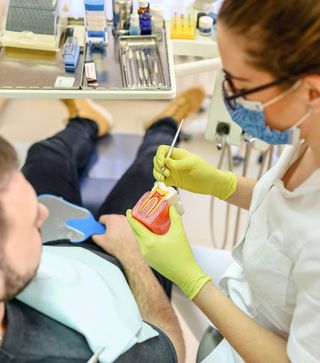
Endodontics (Root Canal) is a specialist type of dentistry that focuses on the soft pulp in the roots of your teeth.
When the tooth’s nerve becomes inflamed or grossly infected, either due to trauma or extensive decay, then it is very likely that the tooth will become symptomatic and cause pain.
Unfortunately, the only nerve fibres that we have in teeth are ‘pain’ fibres. In order to relieve the pain, the infected internal contents of the tooth will need to be removed in a process known as root canal treatment.
The ultimate aim of root canal treatment is to clean out and disinfect the internal dental pulp space. This treatment will prevent the tooth from becoming re-infected.
Root canal treatment is often performed in two appointments.
First Appointment
The first appointment is often an ‘emergency’ appointment where the aim is to get you out of pain ASAP.
At this appointment, you will be given a local anaesthetic and the area where the nerves and blood vessels are housed will be located, and the cleaning process commenced.
A local antibiotic and anti-inflammatory will be placed in the internal pulp chamber and the tooth temporarily restored. Within a day, (in some lucky cases instantaneously) your tooth will be feeling significantly better.

Second Appointment
At the second appointment, the dentist will use special files and irrigants to clean and shape the internal dental pulp space.
The space is then filled with an inert rubberised material and then restored ready for a crown to be placed at a subsequent appointment.
As root treated teeth have often been extensively damaged due to decay or trauma, it is paramount that this weakened tooth is protected from breaking.
It is strongly recommended that all root treated teeth have a crown placed to strengthen and protect the tooth. We recommend all root treated posterior teeth to have a crown placed.
Following placement of the crown on the root treated tooth, the entire tooth will still function and look like the surrounding teeth. The only difference is that you will not be able to feel ‘hot and cold’ sensation.
Frequently Asked Questions
As a result of trauma or severe decay, sometimes a tooth's nerve can become highly inflamed or infected, causing severe pain. In such cases it is necessary to remove the infected and dead tissue from inside the tooth, to relieve the pain, prevent abscesses, and save the tooth from having to be extracted.
Our Geelong-based root canal specialists can treat the majority of cases in just two visits, using local anaesthesia. The treatment doesn't hurt, and should feel much the same as getting an ordinary filling done.
Although some people feel like it would be easier to remove the affected teeth, what many people don't realise is that extraction, which is the only alternative to Root Canal therapy, can lead to periodontal disease, or cause other teeth to shift in your mouth. This may result in problematic gaps developing between the existing teeth, causing changes in bite or facial appearance. This is why our root canal dentists in Geelong recommend retaining natural teeth and receiving proper treatment.
The priority of the first appointment is to relieve pain as quickly as possible. You will be given local anaesthetic, then the root canals will be cleaned to remove all the infected pulp, and any abscesses that are present will be drained. A temporary filling will be put in.
At the second appointment, the dentist will disinfect and mould the internal dental pulp space, ready for a crown to be put on at a later stage, which will protect and strengthen the tooth.
You may feel tenderness around the tooth in the first few days following your root canal treatment. Geelong Smile Studio would like to reassure you that this is normal and that these symptoms are temporary. You may find it helpful to take some mild painkillers during this time. After treatment your tooth will restore full function.
Historically, a root canalled tooth would become darker. However due to current dental technology and modern techniques this is not common nowadays.



